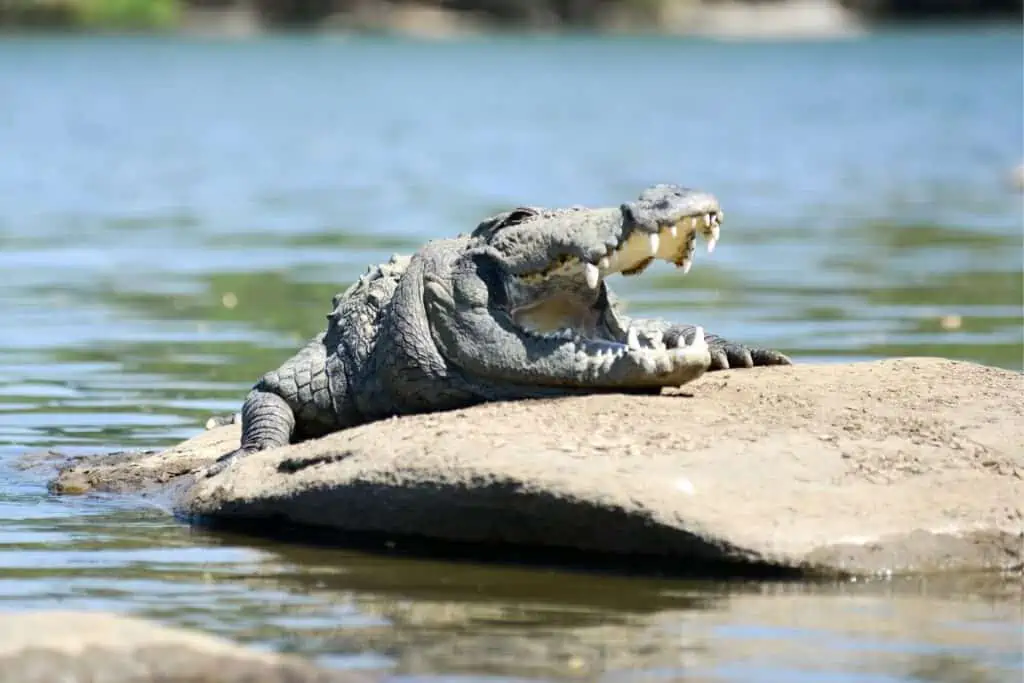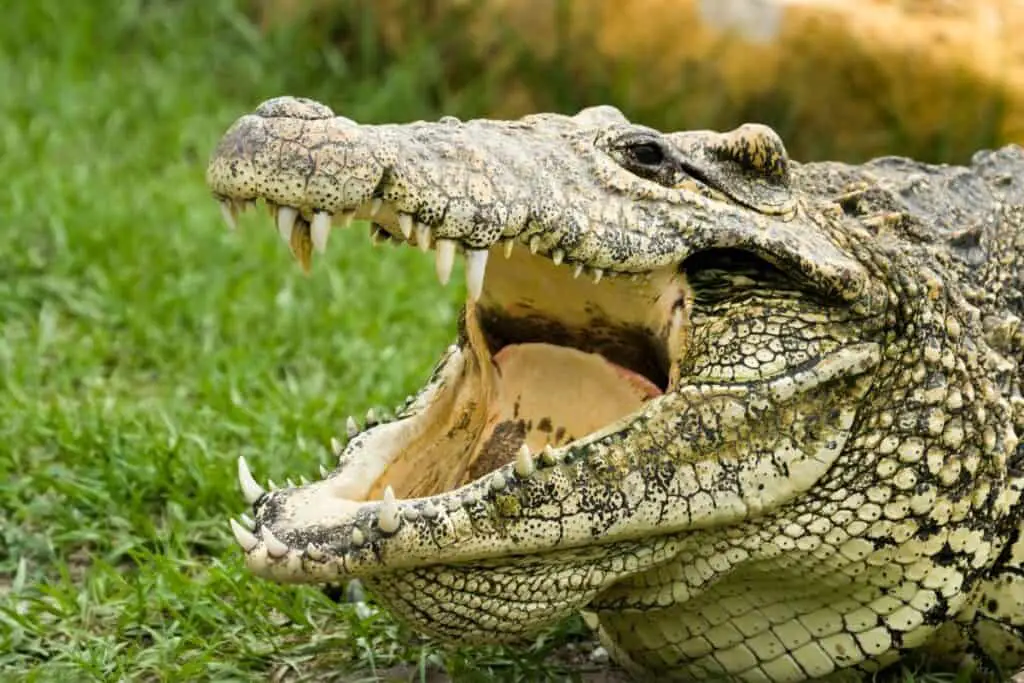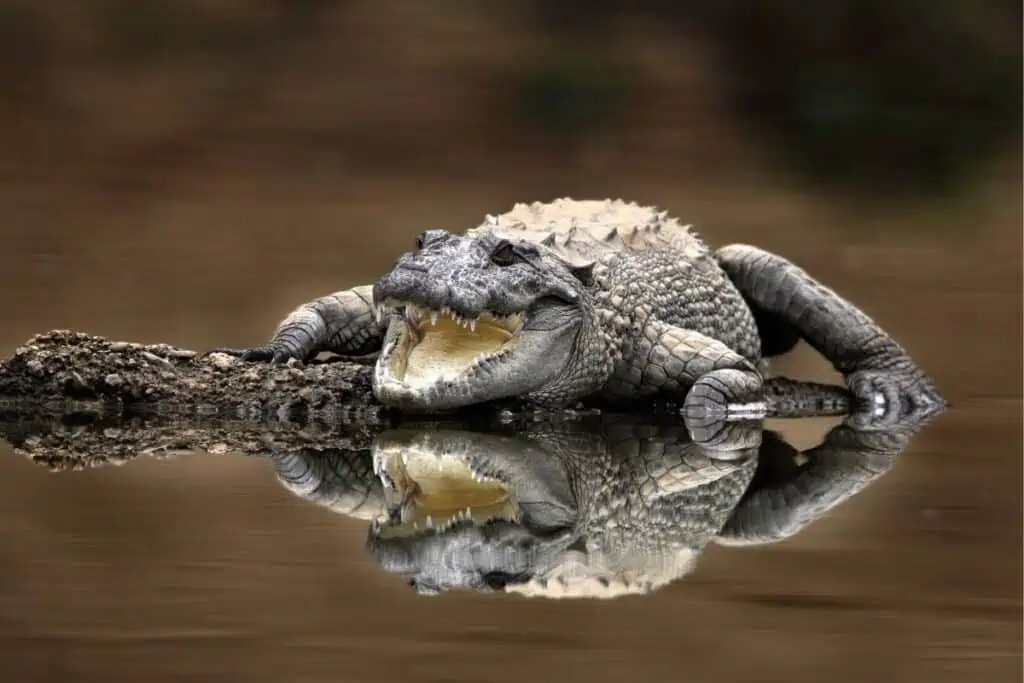Crocodiles form part of some of Earth’s oldest and most iconic animals. These massive reptiles have been around for millions of years and play an essential part in our ecosystem. They have also been part of human cultures for just as long.
Today, however, some crocodiles are endangered and vulnerable.
Many crocodile species are endangered and near extinct for several reasons. They are losing their habitat and are being hunted. Furthermore, invasive species are harming their environment, and their meat is also used for trading. Climate change is another reason many crocodile species are endangered.
While crocodiles are essential for the environment and ecosystem, many face extinction.
In this article, we will discuss why crocodiles are endangered, which species are classified as endangered and vulnerable, and what you can do to help.

Why Are Crocodiles Endangered?
Crocodiles are endangered because people are destroying their natural habitat. For example, crocodiles thrive in rivers and marshes with warm water year-round.
When people build houses or farms in these areas, it can destroy the crocodile’s habitat.
Hunting, invasive species, the bushmeat trade, fishing, and climate change are also some of the main reasons.
Let’s break down each of these reasons in more detail:
Habitat Loss
According to Crocodiles of the World, croc’s habitat loss can be caused by many reasons, including:
- Logging
- Siltation of rivers
- Drainage of wetlands
- Dredging of coastal wetlands
- Sand-mining along rivers
- Dams and barrages
- River diversion and water extraction for agriculture
- General urban development
- Pollution from human activities (far too numerous to mention!)
- Conversion of forest to agricultural land
- Use of riverbanks for human activities
Hunting
Hunting is another big problem for crocodiles. People often hunt them for food or money, even though it is illegal in most places.
However, some people also hunt them for sport or to sell their skin to others to make belts, purses, shoes, etc.
Climate Change
Crocodiles also face a very serious threat from climate change. As temperatures around the globe rise, so does the temperature of the water near the crocodiles’ habitat.
This can make it hard for them to survive, especially when they are young and need to eat a lot.
Fishing
Sometimes, fishermen will kill crocodiles out of fear; additionally, these creatures can become tangled in fishing nets and either drown or be killed as a nuisance to fishermen.
Some fishermen don’t follow the hunter’s code and use explosives to catch fish, killing crocodiles and all other aquatic life in the vicinity.
Others employ poisons that also present a risk to crocs.
The Bushmeat Trade
The bushmeat trade is also a significant factor in the decline of populations of crocodiles.
This is especially evident for dwarf crocodiles, often over-harvested for sale in regional bushmeat markets.
Invasive Species
Invasive species can create various problems – for example; certain invasive plants can clog waterways and reduce food availability for local crocodiles.
In addition, some invasive species are breeding out of control in Southern Florida, causing problems for the local alligator population.
Endangered Crocodile Species
Because of the above reasons, the International Union for Conservation of Nature (IUCN) Red List includes all crocodile species on its list of endangered animals.
In addition, there are five different species of crocodiles that are considered critically endangered.
These include:
Cuban Crocodile (Crocodylus Rhombifer)

As a top predator and ecosystem engineer, the Cuban crocodile plays a key role in preserving the ecosystem.
Today there are only around 3,000 Cuban Crocodiles remaining in their natural habitat. They are hunted mainly for their skins.
Siamese Crocodile (Crocodylus Siamensis)
The decline of the Siamese crocodile population was caused by rice farmers encroaching on their wetland habitat.
However, the drastic increase in commercial hunting and large-scale farming in the 1950s to support the international skin trade pushed the species toward near extinction.
Philippine Crocodile (Crocodylus Mindorensis)
Due to exploitation and unsustainable fishing practices, such as dynamite fishing, the Philippine crocodile was classified as critically endangered in 2008.
As the name suggests, this species is indigenous to the Philippines.
Orinoco Crocodile (Crocodylus Intermedius)
You can find Orinoco crocodiles in Colombia and Venezuela.
People hunted this species to near extinction for their meat, skin, and teeth (some believe they possess healing qualities).
Slender-snouted Crocodile (Mecistops Cataphractus)
The IUCN Red List classifies this crocodile as critically endangered. The main threats to this crocodile’s survival are hunting, overfishing (the crocodiles feed on fish), and habitat loss.
The species can be found in western tropical Africa, from Lake Tanganyika and Lake Mweru to the Gambia River.
Vulnerable Crocodile Species
Four crocodile species are listed as vulnerable: the Tomistoma, American crocodile, mugger crocodile, and dwarf crocodile.
Tomistoma
The Tomistoma is also known as the False gharial. Historically, people used to trade Tomistoma skins. Unfortunately, humans usually ate meat and eggs.
Presently this crocodile is threatened due to the severe depletion of its vital nesting habitat.
People are degrading their natural environment through illegal and commercial logging, agricultural expansion, and the draining of swamps for construction and forestry.
American Crocodiles
The American crocodile is categorized as “Vulnerable” by the IUCN Red List and the U.S. Fish and Wildlife Service and is protected under the Endangered Species Act.
The American crocodile is vulnerable because Americans used to hunt crocodiles for their hides, which caused drastic reductions in population numbers.
Mugger Crocodile

The mugger crocodile lives in freshwater environments, like marshes, lakes, rivers, and artificial ponds, from southern Iran to the Indian subcontinent.
According to studies, water pollution, habitat destruction, sedimentation, food shortage, egg collection, and seasonal water level fluctuation are the main factors threatening Mugger crocodiles.
Dwarf Crocodile
You can find the dwarf crocodile in West Africa.
Unfortunately, unregulated hunting, habitat destruction, and other human activity are severely impacting the population numbers of this crocodile species – especially in areas where they are not legally protected.
How You Can Help
Saving crocodiles from extinction is possible, just not easy. However, there is a lot you can do to help this reptile.
Before you can start helping, you will need to educate yourself about crocodiles and the environment. You can also read up on crocodile conservation.
You can also learn how you can make changes to the environment that will benefit crocodiles and biodiversity.
Fortunately, many organizations are working hard to protect these amazing animals. One of these groups is the IUCN Crocodile Specialist Group (CSG).
The CSG is a non-profit organization with a network of experts advising governments and wildlife management agencies on crocodile conservation.
They also evaluate the conservation needs of crocodilian populations, research, conduct surveys of crocodile populations, provide information, provide training, and initiate conservation programs.
They operate under the Species Survival Commission (SSC) of the IUCN. They also work closely with the Convention on International Trade in Endangered Species of Wild Fauna and Flora (CITES) and other international bodies to promote crocodile conservation and combat illegal trade.
One of the ways you can help is by donating to this fantastic organization since they depend entirely on private donations.
You can also help these animals by planting trees and other plants where they live.
Crocodiles need places to hide from predators, such as birds (when they’re still baby crocs) and humans, so planting bushes around ponds will also be helpful.
You can also start a campaign to remove trash from the areas around rivers, ponds, and lakes.
Also, if you live near a place that has crocodiles, keep an eye out for any signs of human activity, and report anything suspicious to your local wildlife officers.
You can also bring awareness by speaking up about crocodiles being near extinct.
You can write about it on social profiles or talk about it at your school, university, or work. You can also help to gather donations for non-profit organizations.
Final Thoughts On Crocodiles Endangered Status
Many crocodiles are going extinct, primarily due to human activities.
There are five species labeled as endangered and four more labeled as vulnerable by the IUCN. Suppose you want to help.
You can start educating yourself about crocodiles, the environment, and conservation. There are also great organizations to which you can donate to.
